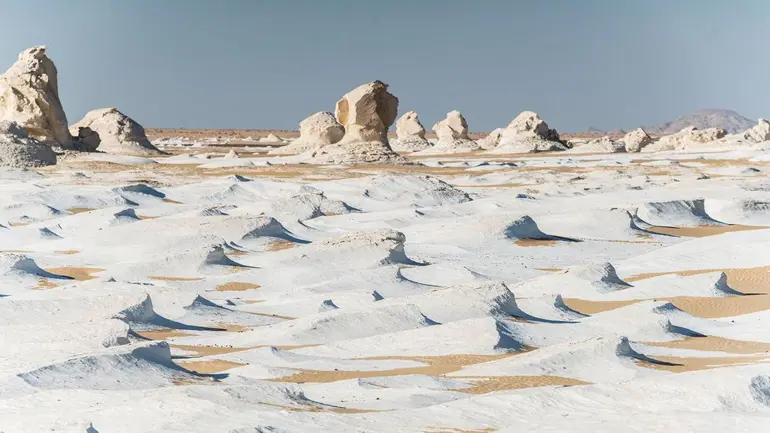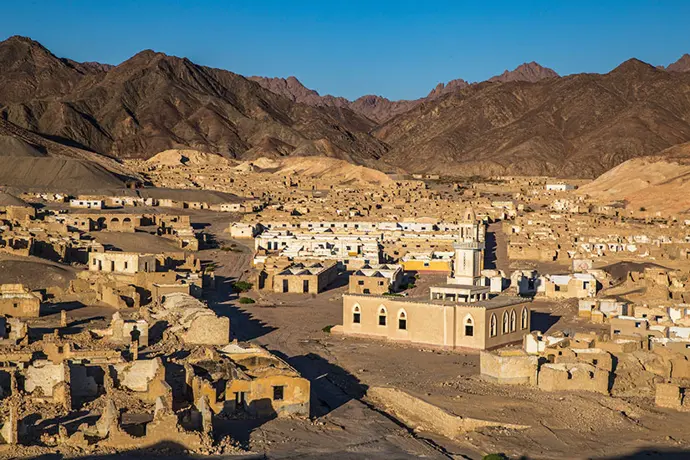Recent News

29
Mar
Unveiling the Secrets: How Old is the White Desert in Egypt
Beneath Egypt’s sun is a canvas of towering white formations that look like they are frozen in time – the White Desert. But just how old is the White Desert in Egypt? According to scientific studies, this rock formation was formed 70–100 million years ago, when dinosaurs walked the earth, and there was water in this region.
A Geological Wonder Frozen in Time.
The White Desert of Egypt, with its pale limestone formations and an other-worldly, moon-like landscape, is one of the most exciting natural museums of the world. The nature reserve is approximately 500 kilometers southwest of Cairo located in Egypt’s Western Desert and encompasses an area of over 3,000 square kilometers. What makes this place so remarkable is not just the stark beauty of the landscape but its incredible geology that dates back through the ages of the Earth. The white chalk rock formations in the desert of unusual shapes that resemble giant mushrooms, big icebergs and abstract sculptures were formed over time, when dinosaurs were still on Earth.
Originating Back To The Time Of Dinosaurs.
Scientists say, the creation of the White Desert dates back 70 – 100 million years ago at the late Cretaceous period. The Tethys Sea Once Covered the whole Region Tethys Sea was the ocean that came between the Laurasia and Gondwana super continent. When the sea creatures died, their calcium present in their body settled on the sea floor. After that, these marine creatures began to accumulate and get compacted into limestone rocks. These rocks are believed to be a part of the sediment that is now developed into the white desert. This limestone is rich in beautifully preserved fossils of ammonites, nummulites and other marine life, important markers by which ages are dated.
About 30 million years ago, tectonic forces pushed the seabed upward to create desert conditions. Though, the white formations we currently see are much younger – after the Holocene period (the last 10,000 years) who showed a constant wind erosion of most of the area. The soft limestone desert rocks can easily be blown away by the wind making them take shape. Scientists estimate that rock erosion rate is about 1 mm/year with present-day climatic conditions.
Human Encounters Through the Millennia.
The geological formation of the White Desert took thousands of years, however, humans have been around for just a blink of an eye. According to archaeological findings, nomadic tribes might have been present in the region since as early as 8000 BCE as evidenced by rock engravings of animals here and hunting scenes. The first people who went to the place must have considered the formations sacred and might have incorporated them into their beliefs.
The desert in the Pharaonic period (3100 BCE to 332 BCE) was a fringe area of Egyptian civilization with caravans passing through occasionally to access the route to the western oases. The Romans ruled Egypt from 30 BCE to 641 CE and were more interested in the area. They would set up many outposts to monitor the trade routes crossing the harsh desert and keep them safe. Medieval Arab travelers wrote about the “white wonder” around the 10th century, but systematized scientific description began only with the European expeditions of the 19th century.
Modern Scientific Revelations.
Research strategies of today have taken our knowledge of the White Desert’s age and formation process far ahead. Modern satellite images as well as radar imaging has shed light on the age of internal resources which may be older than the white salt crust. The study of strata reveals there are twelve layers and the deepest one is some of it dating back to Early Cretaceous or 120 million years old.
New weather patterns influence how quickly an area erodes over time as per simulations. During wetter periods in the Holocene (especially during 9000-6000 BCE), chemical weathering due to occasional rainfall worked along with wind erosion to bring formation. Currently, the area receives less than 10mm of yearly precipitation and wind dominates.
Why the Desert's Age Matters Today.
Comprehending the timeline of geological event can help find more uranium. Understanding the creation speed let conservationist develop strategies to protect fragile formations. In 2002, the Egyptian government designated the area as a national park after studies showed that human activity could cause the erosion of formations that developed over thousands of years, but can be ruined quickly.
The tourism sector brings in over 50,000 visitors to the area each year. Trip reports have shown that better geological knowledge offers great potential for improving education and sustainable tourism. Tour guides will tell you that you cannot touch the formations (skin oil hastens erosion) and that climate change will change future erosion.
From a scientific viewpoint, the White Desert is an open laboratory to understand long-term geological processes. Its layers that are preserved very good give scientists information about the climate of the past. The erosion that happens over there is a great indicator of how the landscape is going to change and with this knowledge scientists can determine how different dry places may behave because of climate change.
A Living Monument to Earth's History.
The rocks that formed the white desert are over a hundred million years old. The shapes of the desert took a thousand years to happen. The culture that produced it is hundreds of years old and counting. Apart from just a tourist destination, the White Desert is also a temporal reminder of the ever-changing Earth. When tourists wander about formations that have existed for millions of years, long before human beings came into the picture, they get perspective on just how ancient the planet is and how young humans are.
The desert keeps revealing fresh content to researchers. A new excavation found fossil beds that had been previously unknown to scientists and may change our understanding of Cretaceous marine life in North Africa. Ongoing monitoring of erosion patterns offers new insight into how fragile geological features respond to ever-increasing human presence and climate fluctuations.
Discover the magic of Egypt’s surreal landscapes—from the bustling streets of Cairo to the mesmerizing White Desert and the tranquil Bahariya Oasis.



_lg.webp)


_lg.webp)

